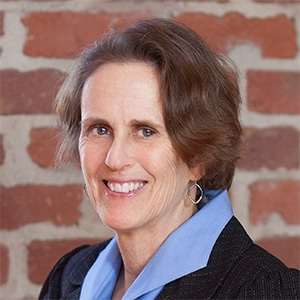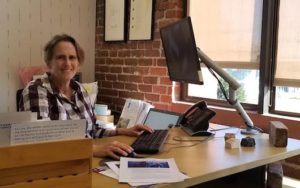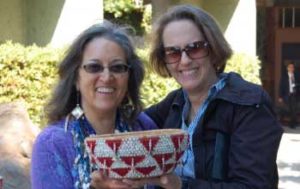
For 25 years — since it came into being — Walter & Elise Haas Fund Arts Program Officer Frances Phillips has served as director of the Creative Work Fund (CWF). That’s oversight of 384 grants, averaging $35,531, for a total of $13.5 million in support of partnerships between artists and nonprofits.
As part of the celebration of the Creative Work Fund’s 25th anniversary, W&EHF Executive Director Jamie Allison interviewed Frances, covering her history with the CWF, how its grantmaking has influenced and been influenced by the Bay Area, and what comes next. That conversation, edited for brevity and clarity, follows.
Jamie Allison: When did you first start working in arts philanthropy?
Frances Phillips: I have only had one job in arts philanthropy, and that is as Arts Program Officer at the Walter & Elise Haas Fund and as the first — and only — director of the Creative Work Fund. When I got hired here, I didn’t realize how lucky I was!
I started on September 1 of 1994, just over 25 years ago. The Creative Work Fund (CWF) had been designed over the nine-month period immediately preceding my arrival.
JA: How do you think your background as a poet and as an executive director of a small arts organization informs your approach as a grant maker for the CWF?
FP: I had been the Executive Director of Intersection for the Arts prior to joining the Walter & Elise Haas Fund, and we faced many tough moments financially. Soon after I arrived, a theater organization that we, at Intersection, were friendly with, came by the foundation with a grant proposal. As I read their financial statement, I saw they were not in good health. In fact, their situation was so dire that I had to go outside and take a walk because my stomach constricted so much. I was caught between my responsibility to protect the Fund’s resources and my desire to see them survive.
I don’t have quite as powerful a visceral reaction these days as I did then, but I still remember how hard it is to be an ED of a nonprofit — and I admire those who do it well. I know what it feels like to be in a tough spot.
As for the poetry, one of my Creative Writing professors at San Francisco State was Stan Rice. He really taught by ear, so in workshops we heard everyone’s work aloud without a lot of reading text on the page. His point was that you have to learn to listen well because you’ll hear when it’s the truth and you’ll hear when it’s artificially artful.
I use that skill all the time as a grant maker; to sense when people are telling me what they think people in philanthropy want to hear and when they’re telling me what’s really going on.
JA: For people who don’t know: what’s the Creative Work Fund’s vision?
FP: The Creative Work Fund was designed to respond to the shifting national attitude in the early 1990s towards supporting artists with public funds. This dialogue arose from public outcry over support of provocative artists, such as Andres Serrano and Robert Mapplethorpe, and it resulted in the National Endowment for the Arts’ budget being cut dramatically with almost all of its fellowships for individual artists eradicated.
In 1993-94, there was also a lot of reconstruction of cultural facilities that had been damaged in the 1989 earthquake. It was a moment of “Oh my, there’s going to be no money for individual artists, but we’re going to have some really nice buildings to put art in…”
So, Susan Clark at the Columbia Foundation gets credit for picking up the mantle. Columbia and several other Haas-related foundations shared the same offices. She talked to the Mimi & Peter Haas Fund, the Evelyn & Walter Haas, Jr. Fund, and the Walter & Elise Haas Fund about pooling funds to offer grants that would benefit individual artists.
 The Walter & Elise Haas Fund was the only one of those four foundations that had an Arts Program Officer position (ed. note: temporarily unfilled), so we were chosen to manage the initiative. The Creative Work Fund designers were going to get it running in three months, but it took them nine. And I often tell this story, because, as I remind applicants to The Creative Work Fund — if you’re going to collaborate, don’t plan to rush.
The Walter & Elise Haas Fund was the only one of those four foundations that had an Arts Program Officer position (ed. note: temporarily unfilled), so we were chosen to manage the initiative. The Creative Work Fund designers were going to get it running in three months, but it took them nine. And I often tell this story, because, as I remind applicants to The Creative Work Fund — if you’re going to collaborate, don’t plan to rush.
The idea of collaboration between artists and nonprofits came, in part, to make the Creative Work Fund distinctive, and part because nonprofit organizations and artists both need to develop collaboration skills. Artists particularly need broad networks. Then, also, there was an understood distinction between artists working in academic settings — “studio artists” — and artists working in the community — making murals, street theater — and the Creative Work Fund wanted to collapse that distinction. We care about artists who are working with one another and with organizations to resolve artistic problems.
JA: What does it take to forge and sustain a successful collaboration?
FP: Trust — which is an easy word to throw around, but difficult to develop — is essential. And a willingness to change or be changed. When collaborations have not gone so well, frequently it’s because one partner wasn’t willing to be patient enough to come to a shared understanding.
Many people have romantic idea about what artists are like. They think artists are like surly adolescents and are going to be difficult and moody.
In reality, many artists work several jobs, do a lot of community social justice work, have exceptionally high ethics, and work long hours. People expect artists to be flaky and irresponsible but, in my experience, they are incredibly dedicated and efficient.
JA: What are the values that underpin the Creative Work Fund?
FP: We don’t believe that there’s any fixed, appropriate point in an artist’s career at which they should apply for a CWF grant. When I first started working on the Creative Work Fund, I thought that recipients would be people who had a lot of career success; that you had to know yourself and have confidence in yourself to bring that to a partnership. That’s not necessarily the case.
There has been a generation of younger artists who don’t want to, or assume they are going to be able to support a studio or a company and work independently. They set out from the start thinking that they will do their work in a community setting.
We don’t believe that choosing to be an artist is choosing to be alone.
JA: What’s uniquely Bay Area about the Creative Work Fund?
FP: We tend to be left leaning, and many of the artists we’ve supported work on content about immigration or the environment or other issues that also are considered left leaning.
A piece of my job is putting together a panel of experts who come together from around the country, and when we’re reviewing applicants for traditional arts grants, I don’t only need to have people who know craft and dance and music, I also need to have people who know China, Japan, Afghanistan… Because when we see who comes through the door to apply each year, we’re seeing the face of the cultures that make up the Bay Area.
We have a unique mix of cultures here. California is very diverse; these are our people.
JA: What are the genres supported by Creative Work Fund?
FP: We have, for quite a few years, had five genre categories — visual, literary, media, traditional, and performing arts — for which grants were available on a rotating basis, with two categories offered each year, but we are experimenting in the coming round with doing away with categories and opening the door to artists working in any genre.
JA: How did you make that decision?
FP: We talked to grantees who told us that if we wanted to see newer and younger artists come forward, we had to remove the constrictions of genre. Some artists work in their communities in interesting, important ways that don’t fit into a niche. Plus, many artists are crossing over and blending genres, so we’re going to experiment, too.
JA: Can you give us a couple of examples of the kinds of projects that Creative Work Fund has supported over the last 25 years?
FP: One of our very first grants was to visual artist Ann Chamberlain who was, at the time, being treated for breast cancer at the Carol Franc Buck Breast Care Center, which was affiliated with UCSF Mount Zion. One day, when she was in the infusion center there, she looked out the window at this ugly concrete courtyard and said to her doctor, “Why can’t people going through this stressful experience have something beautiful to look at?”
So, Ann collaborated with the Breast Health Center. She gathered plants that are used for medicinal reasons in various cultures and made pressings of them into clay tiles. Those clay tiles then were etched with quotes from interviews with staff and patients and patients’ families. The project resulted in a huge tile wall on the hospital corridor that faces the garden. They also tore up the concrete and planted a garden, designed with landscape architect Katsy Swan.
If that was the only project the Creative Work Fund ever funded, it would have all been worthwhile. One’s experience of the place became all about care.

In another project, the California Indian basket weaver, Linda Yamane, who is of Rumsen Ohlone descent, collaborated with the Big Sur Land Trust to remove invasive plants from a property the Trust owned, so that the sedge and other materials Linda needed to create baskets could grow. She created two work baskets, one that you set over a stone for grinding acorns, and another which is more for carrying. One of the things that’s quite beautiful about this project is that they left behind an area where basket-weaving materials are growing and that can be used by other California native artists.
JA: What is it like to be an artist in the Bay Area?
FP: The Bay Area has some big-budget major institutions that plow the field for smaller, riskier arts organizations that are eager to press boundaries. And we also have a pretty great cluster of educational institutions where young people who are developing their skills as artists can learn.
This is a place where people come to remake themselves — that’s one of the reasons I came here. I wanted to be someplace where people were doing challenging and sometimes outrageous things. I grew up in a gated community that was very homogeneous. I didn’t want to live that way and I think that having a rich cultural mix is part of what makes this a good home for artists.
Thinking about the debate over the murals at George Washington High School in San Francisco, or the removal of the Pioneer Monument at the Civic Center, there’s a public forum here where people exchange ideas and values. We can pause and reflect about things here. You may never go to formal art exhibits, but you are still seeing art in your built environment here all the time, even if you’re just glancing at the Jim Campbell piece at the top of the Salesforce Tower.
I feel as if artists here have been safe to experiment and fail, and it’s important to protect that. The process of making art is all about trial and error and making mistakes that lead you to something profound.
JA: Is there anything you’d like to ask me?
FP: Yes! What was one of your top ten Bay Area arts experiences over the last year?
JA: I love this question. I recently went to see the African American Shakespeare Company’s production of Macbeth and it was quite good. It was at the Taube Theater in the Jewish Community Center and I’d never been there before, and I really liked that space.
FP: Nice. That’s great.
JA: Thank you so much Frances.
FP: You’re welcome. Thank you, Jamie.

